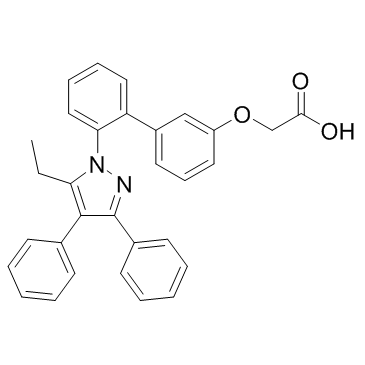300657-03-8
| Name | 2-[3-[2-(5-ethyl-3,4-diphenylpyrazol-1-yl)phenyl]phenoxy]acetic acid |
|---|---|
| Synonyms |
Acetic acid, 2-[[2'-(5-ethyl-3,4-diphenyl-1H-pyrazol-1-yl)[1,1'-biphenyl]-3-yl]oxy]-
{[2'-(5-Ethyl-3,4-diphenyl-1H-pyrazol-1-yl)-3-biphenylyl]oxy}acetic acid 2-[[2'-(5-Ethyl-3,4-diphenyl-1H-pyrazol-1-yl)[1,1'-biphenyl]-3-yl]oxy]acetic acid UNII-M5X9XSU6J5 T4B ((2'-(5-Ethyl-3,4-Diphenyl-1h-Pyrazol-1-Yl)-3-Biphenylyl)oxy)acetic Acid cc-561 [2'-(5-Ethyl-3,4-diphenyl-pyrazol-1-yl)-biphenyl-3-yloxy]acetic acid BMS-309403 |
| Description | BMS-309403 is a potent, selective and cell-permeable inhibitor of fatty acid binding protein 4 (FABP4) with a Ki of less than 2 nM. |
|---|---|
| Related Catalog | |
| Target |
Ki: less than 2 nM (FABP4), 250 nM (FABP3), 350 nM (FABP5)[1] |
| In Vitro | BMS-309403 binds to FABP4 with high affinity and shows over 100-fold selectivity against FABP5 as well as the heart isoform FABP3[1]. BMS-309403 interacts with the fatty-acid-binding pocket within the interior of the protein and competitively inhibits the binding of endogenous fatty acids. Treatment with BMS-309403 significantly decreased MCP-1 production from THP-1 macrophages in a dose- and time-dependent manner[2]. BMS-309403 stimulates glucose uptake in C2C12 myotubes in a temporal and dose dependent manner via activation of AMP-activated protein kinase (AMPK) signaling pathway but independent of FABPs[3]. |
| In Vivo | A 6 week treatment with BMS-309403 improves endothelial function, phosphorylated and total eNOS and reduced plasma triglyceride levels but does not affect endothelium-independent relaxations. In cultured human microvascular endothelial cells, lipid-induced A-FABP expression is associated with reduced phosphorylated eNOS and NO production and is reversed by BMS-309403[4]. The extent of atherosclerotic lesion area in the proximal aorta is significantly reduced in the BMS-309403-treated group compared with vehicle-treated controls in both the early and late intervention studies[2]. |
| Animal Admin | Mice: To determine the effects of pharmacological inhibition of the actions of A-FABP, either the A-FABP inhibitor BMS-309403 (15 mg/kg) or vehicle (4% Tween 80) are administered chronically by daily oral gavage for 6 weeks in ApoE−/− mice (starting at weeks 12 of age). Mice are anaesthetized with a bolus injection of pentobarbitone sodium (230 mg/kg) and their aorta removed and dissected for further analysis[4]. |
| References |
| Density | 1.2±0.1 g/cm3 |
|---|---|
| Boiling Point | 657.5±55.0 °C at 760 mmHg |
| Molecular Formula | C31H26N2O3 |
| Molecular Weight | 474.550 |
| Flash Point | 351.4±31.5 °C |
| Exact Mass | 474.194336 |
| PSA | 64.35000 |
| LogP | 7.69 |
| Vapour Pressure | 0.0±2.1 mmHg at 25°C |
| Index of Refraction | 1.623 |
| Hazard Codes | Xi |
|---|


